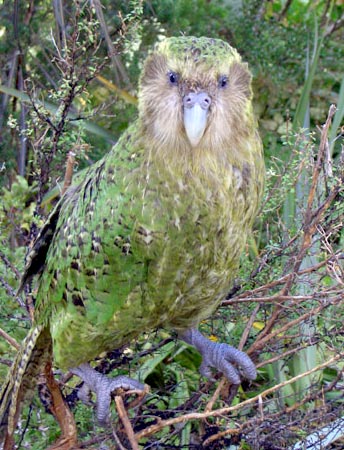The Kakapo Parrot (Strigops habroptilus), a remarkable bird native to New Zealand, captivates ornithologists and nature lovers alike. Known as the “owl parrot,” the Kakapo is the world’s only flightless parrot and also the heaviest. Despite these intriguing characteristics and its once thriving presence, the Kakapo is critically endangered, predominantly due to human activities and invasive species. This has spurred a range of concerted conservation efforts to prevent the loss of this extraordinary species.

Fascinating Characteristics of the Kakapo Parrot
The Kakapo is an extraordinary bird that stands out amongst parrot species. It is a flightless parrot; instead of flying, Kakapos use their short wings for balance and support when leaping between branches or running. They have strong legs that make them excellent climbers and hikers.
Despite being parrots, Kakapos are nocturnal, and their facial disc and large eyes give them an owl-like appearance, hence their nickname “owl parrot.” Their feathers are a mossy green and yellow, providing excellent camouflage against predators.
One of the most unusual aspects of the Kakapo is its breeding system, known as “lek breeding.” In this system, males gather in an area and compete to attract females by making deep, booming calls. Females then select a mate based on these calls and displays.
Habitat and Diet
Historically, Kakapos were found throughout New Zealand’s forests, from coastal regions to high altitude areas. However, due to threats to their survival, Kakapos have been relocated to three predator-free islands off the coast of New Zealand: Codfish Island, Anchor Island, and Little Barrier Island.
The Kakapo is a herbivore. It has a varied diet that includes leaves, bark, roots, and fruits. Kakapos are also known to eat the roots and tubers of native plants, which they dig out of the ground with their strong beaks.
Threats to the Kakapo Parrot
The primary threats to the Kakapo are human activity and invasive species. With the arrival of the Maori and later European settlers in New Zealand, the Kakapo’s habitat was significantly reduced due to deforestation for agriculture and settlement. Hunting for their meat and feathers also contributed to their decline. Furthermore, the introduction of mammalian predators like rats, cats, and stoats posed a significant threat. Since Kakapos are ground-dwelling birds, they were particularly vulnerable to these predators, which hunted the Kakapo’s eggs, chicks, and adults.
Efforts to Restore the Kakapo Parrot
The New Zealand Department of Conservation initiated the Kakapo Recovery Program in the 1980s to save the Kakapo from extinction. This program involves several strategies:
1. Safe Havens: Kakapos have been relocated to predator-free islands, which serve as safe habitats for the birds. These islands are closely managed and monitored to ensure the continued safety of the Kakapo population.
2. Breeding Programs: Given the Kakapo’s low reproductive rate and unique lek breeding system, breeding programs have been crucial. These programs use artificial insemination and supplementary feeding to boost Kakapo numbers.
3. Genetic Management: With the Kakapo population being so small, maintaining genetic diversity is a significant challenge. Geneticists are working to ensure the genetic health of the Kakapo population, thus preventing the problems associated with inbreeding.
4. Public Awareness and Community Involvement: Efforts to raise awareness about the Kakapo’s plight and involve the community in conservation efforts have played a crucial role in garnering support for the Kakapo’s preservation.
Conclusion
The Kakapo parrot, with its unique characteristics, intriguing behaviors, and unusual breeding system, is a remarkable representative of New Zealand’s biodiversity. Its story underscores the profound impact of human activities and introduced species on native wildlife. Yet, the ongoing conservation initiatives to restore the Kakapo population also demonstrate our capacity to rectify past errors and work towards safeguarding our planet’s unique species.
While the journey towards recovery is long and fraught with challenges, the progress made thus far offers hope for the future of the Kakapo. This hope is a testament to the power of dedicated conservation efforts, informed public awareness, and committed community involvement. As we continue these efforts, we contribute to a future where the deep, booming calls of the Kakapo continue to echo through the forests of New Zealand, reminding us of the richness of our world’s biodiversity and our responsibility to protect it.
Help us Help Them! Think Wildlife Foundation is a non profit organization with various conservation initiatives. Our most prominent campaign is our Caring for Pari intiative. Pari is a rehabilitated elephant at the Wildlife SoS Hospital. 25% of the profits from our store are donated to the elephant hospital for Pari. Other than buying our wonderful merchandise, you could donate directly to our Caring For Pari fundraiser.
Written by: Sanghmitra Singh
